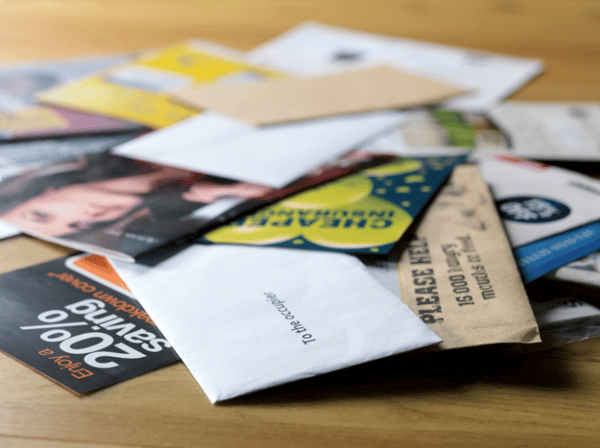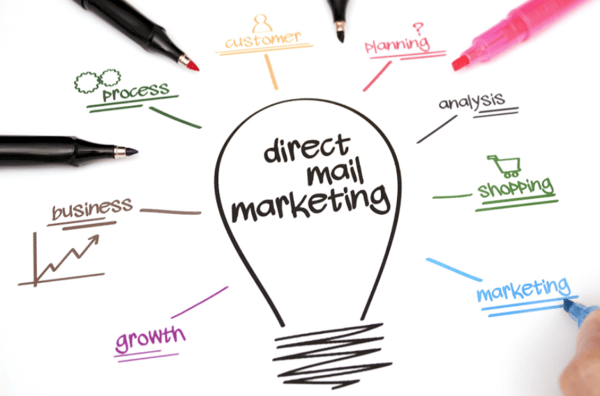The boom of technology in the 21st century has changed the landscape of marketing. With so much focus on digital advertising, it can be easy to forget about the power of direct mail marketing and how a direct mail campaign can have a major impact on the success of your business. Here we’ll outline what direct mail marketing is, how it works, and how you can maximize your next campaign to get the results you’re looking for.
What is direct mail marketing?
Before diving right in and launching a successful direct mail campaign, it’s important to understand what direct mail marketing is. Direct mail is targeted, unsolicited, unrequested ads which include sales letters, postcards, booklets, etc. Direct mail marketing is any physical correspondence a company or business sends out to its target audience with the goal of getting them to patronize their business.

- Is direct mail marketing relevant?
It may seem like the days of direct mail advertising may be over, but this method of marketing has unique benefits that make it timeless. Direct mail is a great way to interact with your target audience and nurture relationships with customers and patrons. It’s an easy way to communicate information without the concern of getting lost in someone’s inbox. Sending out creative, meaningful print pieces can leave a lasting impression on audiences and set your business apart from your competitors’. The United States Postal Service (USPS) reports that 58% of the mail American households receive is made up of marketing mail.
- Does direct mail marketing still work?
Direct mail is still an effective way to reach and gain customers! Unlike digital marketing campaigns such as email funnels, your business or company has access to send print materials to anyone within their target audience without an opt-in mechanism. Because of this, your company is able to reach a wider audience, raise brand awareness, and ultimately convert audiences into patrons. According to CMO Council, 4 out 5 recipients say they have read or scanned a direct mail piece and acted on it right away. Recipients are more likely to hold onto and share direct mail pieces, especially if there is a direct response offer. The Data & Marketing Association (DMA) reports that direct mail response rate is between 5% and 9%, up to 9 times higher than that of an email which comes in at just 1%.
- Who is direct print marketing for?
Direct print marketing is for everyone. In fact, according to allbusiness.com, 56% of people feel that direct mail advertising is more trustworthy than any other method of advertising. Millennials in particular are aware of the spread of misinformation or unreliable online sources, and therefore feel more confident in responding to a direct mail piece. However, people aged 45-54 is the group most likely to respond to a direct mail campaign (DMA).
- Why choose print?
Print marketing is more than a way to reach (and gain) customers. Print marketing allows your business to stand out, be creative, and see higher customer conversion rates. With over 50% of the marketing world comprised of digital advertising as of 2019, many companies never think to include direct mail services into their advertising efforts. Print marketing carries more weight and leaves a stronger impression on its recipients than digital marketing. Canada Post reported that direct mail requires 21% less cognitive effort to process than an email, making it more likely to be read and responded to.
Outside of email, digital marketing can often be limited by size, space, and visibility from search engine platforms and social media algorithms. With overwhelming competition, it can be a challenge to make digital content alone stand out from the crowd or even be seen by your target audience.
What are the benefits of direct mail?
If you’re still not convinced that direct mail is the right choice to add to your marketing strategy, consider the many benefits of print.
Beyond the statistics supporting the success of direct mail campaigns, adding direct mail as a component of multi-media marketing campaigns is one of the most effective ways to drive your response rates and customer conversion rates up. By combining print and digital marketing, you’re able to ensure that your message is seen by the most desired audience. Direct mail takes many forms, giving you the option to choose the format that best supports your business’ needs.
Direct Mail Formats for Maximum Impact
It can be challenging to determine which direct mail format is the best choice for your company. Here’s a breakdown of what each format offers and how it can maximize impact:
Postcards: Postcards are one of the least expensive options for direct mail, and are one of the most popular options at Premier Print Group (PPG). They require as little additional postage as possible, are not folded, and contain no inserts. Postcards can be printed front and back and have a high likelihood of being read by your audience.
Folded Self-Mailers: A single sheet of paper folded into panels (bifold, trifold, or oblong) with sealing along the edge. These do not require a separate envelope, and all mailing information is printed directly onto the paper. Because of their larger size, there is more space to share your message and add eye-catching visuals. These mailers offer greater privacy for more personalized messages, and are cost effective.
Envelope Mailers: Envelope mailers are sent with the greatest level of privacy. This form of direct mail looks and feels personal, and may include multiple inserts such as response cards. The cost will be determined by the size and weight of the envelope and its contents.
Letters: One of the most personal ways to reach your customers. Letters are usually one to two pages and can include inserts like response cards, customer testimonials, or even brochures. Like envelope mailers, the cost will depend on the size and weight of your envelope.
Dimensional Mailers: This is a form of interactive marketing that encourages the recipient to do more than just respond to the offer, but to engage with the piece itself. If you’ve ever received an envelope with something inside – a pen, a calendar, etc. – you’ve received a form of dimensional mail. Dimensional mailers can also be 3-D pieces that require extra shipping and care such as boxes, tubes, bags, etc. It is the most effective form of direct mail, with recent studies showing an open rate of up to 100%. Because of the variability of dimensional mailers, cost can vary. Targeting high-value recipients leads to the best results.
Publications/Catalogs: Publications are the ultimate way to engage with your audience. According to the USPS, the average time spent looking through a catalog is 15.5 minutes and recipients hold onto them for several weeks. Publications offer businesses the ability to share their business’ message through more personal stories. Additionally, as an active form of marketing, catalogs can influence purchasing decisions because they demand that recipients take an action. While these require more preparation to print and mail, the payoff has tremendous benefits to your business.
Best Practices to Create a Digital Mail Strategy

With so many options for your marketing campaign, it’s important to evaluate which is the best way to ensure your marketing efforts are successful and beneficial to both your business and your target audience.
Step 1: Review past marketing efforts. Identifying which past marketing methods were successful and which ones were not will help narrow your decision. It’s important to keep in mind the cost: how much you spent and what your results were.
Step 2: Identify target audiences. Knowing your target audience is crucial to the success of your campaign. Whether you’re looking to expand your brand awareness to a new community or foster your relationship with faithful customers, knowing what their needs and wants are will give you the best idea of what message to send and how to send it.
Step 3: Determine the best format. As outlined above, there are many options to reach customers through direct mail, and selecting the best one(s) for your business is central to a fruitful campaign. PPG can help you generate ideas and lead you in the right direction.
Step 4: Create a custom design. Add your personal message, images, and layout. PPG will ensure the highest standard print quality of every piece.
Step 5: Print and mail your campaign piece. Once you’ve approved the final version of your piece(s), it’s time to print and mail to your recipients! Printing companies may handle this aspect for you, and often will pull mailing lists that are predetermined during the project life cycle or provided by your business.
Step 6: Report and analyze results. The final step is to evaluate the data. This information is crucial in knowing what methods of your marketing campaign worked well and what areas need improvement. Be sure to keep a clear record of all results to make this process go smoothly.
The Direct Mail Printing Process with Premier Print Group
Whether your business is brand new to print marketing or you’ve been using it for years, PPG offers the same exceptional experience to every client. From first contact to shipping and mailing, we follow a simple formula:
- Connect – Each project is assigned a designated project manager to verify product specs, create a job ticket and confirm a ship date. You will receive an order confirmation detailing all specs and your project’s completion date.
- Design – Our creative team is there to assist you throughout the entire process. As specialists in the development and design of all types of commercial print projects, we offer top-of-line creative services to our clients.
- Proof – After your files have been carefully reviewed and approved, the proofing process begins. Premier offers two types of proofs: PDF (post Raster Image Processing) and hard copy Epson Digital Dylux and Digital Contract proofs. All proofs must have client approval before production begins.
- Print – Once proofing is completed and approved, the files are sent to our Kodak Magnus 800 Platesetter where plates will be automatically processed and output. They are then forwarded to the press for printing. If the project is printing digitally, due to shorter runs or variable data printing, for example, the files are sent directly to our NexPress Digital Press.
- Mailing - PPG is able to ship or mail your projects. For standard mailing projects, a mailing list is needed from the customer. Your business may have an existing database for us to use, or PPG can help clients buy lists based on demographics, geographics, and/or psychographics. We also offer additional mailing services such as fulfillment, warehousing, distribution, inserting, match mail, in-line tabbing, and Every Door Direct Mail (EDDM).
Premier Print Group is committed to providing high-quality services and products. Our team of experts is happy to review your projects and assist you in determining the best printing methods. Contact us today to start the conversation.




